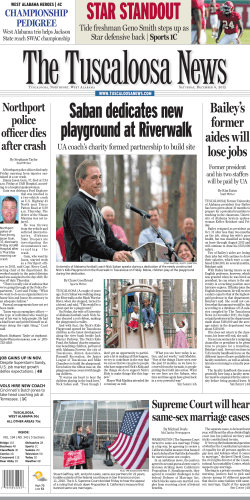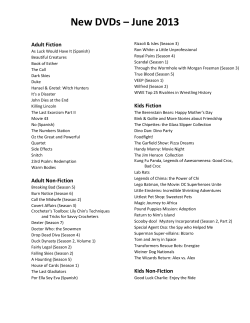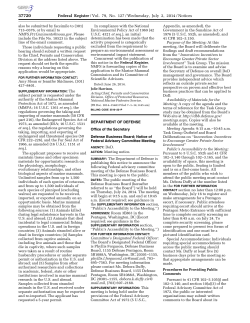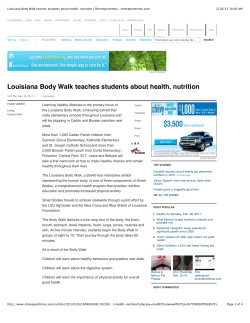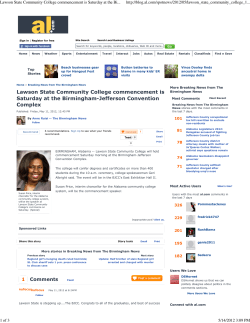
Nick Saban Bio (February, 2013)
Nick Saban Bio (February, 2013) A man of vision who has a proven record of championship success, head coach Nick Saban has returned the University of Alabama to the top of college football landscape with his commitment to building the total program. After the most recent victory over Notre Dame in the BCS National Championship game on January 7, 2013, Saban joined Frank Leahy, Bear Bryant and John McKay as the only coaches to win four national titles in the modern era. Entering his seventh season in Tuscaloosa, Saban’s uncompromising dedication to excellence in every phase of the program has resulted in the school’s 13th, 14th and 15th National Championships and the foundation has been set to yield long-term success for the Crimson Tide. A five-time National Coach of the Year, Saban has achieved resounding success as a head coach and has earned a reputation as an outstanding tactician, leader, organizer and motivator. Those qualities have sparked impressive turnarounds at every stop of his career. Saban’s consistent approach and disciplined leadership are the reasons his teams are known for exhibiting grit, determination and resilience, often overcoming adversity to achieve victory. Saban has compiled a 154-55-1 (.737) record as a college head coach and has gone 61-7 (.897) in the past five seasons in Tuscaloosa, which includes a 35-5 mark in regularseason conference play. In 2012, the Tide reached the 10-win milestone for the fifth consecutive season under Saban. With another SEC Championship win and BCS National Championship Game victory last season, Saban is now 8-1 all-time in conference or national championship games. Alabama remained at the forefront of the college football world in 2012 with an explosive offense and a retooled defense that maintained its place as the most dominant units in the nation. The Crimson Tide won the program’s 23rd SEC Championship (the most in league history) with a victory over Georgia that propelled Alabama into the 2013 Discover BCS National Championship Game, where they soundly defeated Notre Dame by a score of 42-14 to record the school’s 15th national title. For his efforts following the season, Saban was named the Bobby Bowden National Coach of the Year for the third time in four years. The Alabama defense lead the nation in rush defense (76.36 ypg), total defense (250.0 ypg), and scoring defense (10.93 ppg) in 2012. The Tide offense ranked 12th nationally in scoring at 38.71 points per game and 16th nationally in rushing at 227.5 yards per game. The Crimson Tide set a school record with 542 points scored in 2012. In addition, Alabama extended a streak of consecutive weeks in the AP Top 25 to 81 weeks, the longest in school history. The Crimson Tide featured four first-team All-Americans in 2012, including two along the offensive line in center Barrett Jones and left guard Chance Warmack. A pair of defensive standouts also earned All-America honors in cornerback Dee Milliner and linebacker C.J. Mosley. Jones captured the Rimington Trophy, which goes to the nation’s best center, and the prestigious Campbell Award, given to the student-athlete that best combines performances on the field, success in the classroom and service away from the field. The 2012 senior class set the school and SEC record for wins while garnering a 49-5 record since 2009, a mark that tied Nebraska’s 49 wins from 199497. It also broke the Cornhuskers’ record (60 wins from 1993-97) for the most victories in major college football over a five-year period with (61 wins from 2008-12). The 2011 squad produced one of the most dominant defenses in the history of college football and captured Alabama’s 14th national championship with a 21-0 victory over LSU in the BCS National Championship Game. The Tide defense led the nation in all major categories, becoming the second team since national statistics began being kept and the first since 1986 (Oklahoma) to accomplish this feat. Alabama allowed only 8.2 points per game, 183.6 total yards, 72.2 rushing yards, 111.5 passing yards and a 83.7 pass efficiency defense. Alabama finished with a 12-1 record. Saban’s 2011 senior class won 48 games over the span of four seasons (2008-11). Seven members of the 2011 Crimson Tide (including five on defense) were recognized as first-team All-Americans by major media outlets, while Barrett Jones took home Alabama’s third Outland Trophy and Heisman Trophy finalist Trent Richardson received UA’s first Doak Walker Award. The team was recognized with the Disney Spirit Award, which was presented to snapper Carson Tinker, for the team’s response to the community following the tornado that devastated Tuscaloosa on April 27, 2011. Jones also captured the ARA Sportsmanship Award and the Wuerffel Trophy. Saban’s efforts also earned him the Bobby Bowden National Coach of the Year Award, the second such honor in the past three years. The Tide also had extensive success in the classroom with 38 SEC Academic Honor Roll selections (a league record) and produced an Academic All-American in Jones. Despite a young roster that listed only eight scholarship seniors, the 2010 Alabama team finished with its third consecutive 10-win season following a dominant 49-7 win over Michigan State in the Capital One Bowl. Five players were named first team All-SEC by either the AP or the league coaches, while six more earned second team AllSEC honors. Most impressively, two players (quarterback Greg McElroy and Barrett Jones) were named first-team CoSIDA/ESPN Academic All-Americans, which marked two consecutive years in which Alabama boasted two of the three ESPN Academic All-Americans in the SEC. McElroy, the ESPN Academic All-American of the Year, was named a National Football Foundation National-Scholar-Athlete as a finalist for the Campbell Trophy. The 2009 season at Alabama turned out to be one of the most memorable in program history as the Tide compiled a perfect 14-0 mark and won the 2009 BCS National Championship by defeating Texas by a score of 37-21 at the Rose Bowl in Pasadena, Calif. Alabama earned a spot in the title game with a resounding 32-13 win over defending national champion Florida in the SEC Championship Game as the Tide moved to No. 1 in both major polls. The SEC championship was the program’s 22nd. On December 12, 2009, more history was made for both Alabama and Saban when running back Mark Ingram became the first Heisman Trophy winner for both. Saban’s 2009 squad also was prominent when it came to other honors, as Rolando McClain received the Butkus Award as the nation’s top linebacker and six players earned firstteam AP All-America status – a college football record. After the perfect season concluded, Saban was presented with the first Bobby Bowden National Coach of the Year Award. In addition to the on-field success, the 2009 Tide active roster featured a nation’s-best 13 players who already had graduated. That number increased to 22 players with degrees for the bowl game. Saban’s first UA team finished 7-6 in 2007, but the 2008 season saw a vastly improved Alabama squad take the field. Saban’s influence had taken hold in Tuscaloosa and – behind a small and united senior class along with a talented group of newcomers – the Tide returned to national prominence. Alabama developed a reputation as the most physical football team in the country and methodically dominated the competition. Saban produced the largest win increase from year one to year two in school history, as the Tide went from a seven-win team in 2007 to 12 wins in 2008. Alabama swept through the regular season schedule with a 12-0 record, moving to No. 1 in all of the polls and capturing the SEC Western Division Championship before falling late to Florida in a hard-fought SEC Championship Game. The team’s efforts earned them a trip to the Allstate Sugar Bowl for the 13th time in school history. Saban was named the 2008 Home Depot Coach of the Year at the ESPN Awards Show in Orlando and won several other national coach-of-the-year honors including the FWAA/Eddie Robinson, Associated Press, The Sporting News, Walter Camp Football Foundation, and Liberty Mutual. Lessons learned from the 2007 season – which was capped with a win over Colorado in the Independence Bowl – no doubt carried into spring and summer preparations for the 2008 run. The win also continued an impressive streak for Saban as he has never had a losing season as a college head coach. Of the six losses in 2007, none was by more than seven points. In addition to an improvement in the win-loss column from the year prior, the 2008 signing class was rated by many analysts as the best in the country. Off the field, the focus on academics by Saban and his staff made an immediate impact as the 2007 team put together one of the finest academic fall semesters in school history. The freshman class set a solid foundation for their future at UA as they led the way with an impressive combined GPA of 3.10 in the fall. Before arriving in Tuscaloosa, Saban’s most recent college head coaching stint was a five-season run at LSU which produced a record of 48-16 (.750), one national championship (2003), two Southeastern Conference championships, three SEC West Division championships, and a 3-2 record in bowl games, including two Sugar Bowl victories and a Peach Bowl win. The Tigers constructed a 28-12 (.700) record against SEC opponents under Saban’s guidance. He was named the 2003 National Coach of the Year by the Associated Press and earned both the Paul W. “Bear” Bryant National Coach of the Year Award and the Eddie Robinson Coach of the Year Award by the Football Writers Association of America. Saban was named SEC Coach of the Year twice (by The Birmingham News in 2001 and by the Associated Press in 2003) while at LSU. Saban took over the Alabama program after serving two seasons at the helm of the Miami Dolphins. Saban’s teams showed marked improvement over the unit he inherited. Taking over a team that finished 4-12 in 2004, Saban led the 2005 Dolphins to a 9-7 record, the third-biggest turnaround in the NFL that season and the second-highest victory turnaround for a Dolphins team in any non-strike season. Most impressively, the Dolphins finished 2005 on a six-game winning streak to end the year, the longest streak in the NFL that season. Prior to his stint at Miami, Saban’s impact on the LSU program transcended the success on the field. His commitment to building the total program, placing education first and instilling discipline with responsibility on and off the field transformed the Tigers into a force on the national stage. LSU produced 84 Academic all-SEC honorees in Saban’s five seasons, including 25 members of the 2003 National Championship squad. LSU’s graduation rate for football players improved dramatically under his watch and two players – offensive tackle Rodney Reed (2002 and 2003) and offensive lineman Rudy Niswanger (2004) – earned first-team Academic All-America honors. Linebacker Bradie James earned a postgraduate scholarship from the National Football Foundation (2003). Saban also spearheaded a $15 million fundraising effort to fund a new academic center for student-athletes at LSU, and he and his players were active in community involvement in the Baton Rouge area, taking part in community service projects, visiting schools to mentor children, and taking time to visit local hospitals on a regular basis. More than 50 of Saban’s LSU players earned their college degrees, in addition to 28 who were selected in the NFL draft (including seven in both 2004 and 2006). Named head coach at LSU on Nov. 30, 1999, he led an immediate turnaround of a program that had suffered through seven losing seasons during the 1990s. His 48 victories over five seasons were the third-most among Division I-A head coaches during that time. Saban, Paul Dietzel and current LSU head coach Les Miles are the only coaches in the program’s history to post multiple 10-win seasons. Saban, Dietzel and Bernie Moore are the only head coaches in Tiger history to win two SEC championships. Saban’s 2000 Tigers rebounded from two straight seasons to post an 8-4 record, capped by a 31-20 win over 15th-ranked Georgia Tech in the Peach Bowl. Home victories over Tennessee, Mississippi State and Alabama highlighted the season, along with a key road win at Mississippi. The 2001 Tigers improved to 10-3 overall and won the program’s first outright SEC title since 1986 with a 31-20 win over second-ranked Tennessee in the SEC Championship game. An impressive second half against the Volunteers was a trademark of Saban’s coaching acumen, as the Tigers outscored the Vols 21-3 in the final half to erase a 17-10 deficit. LSU won the game despite the absence of starting quarterback Rohan Davey and running back LaBrandon Toefield. Sparked by one of the most prolific offenses in the nation, a unit that averaged 451.5 yards per game, the Tigers capped the season with a 47-34 defeat of Big Ten champion Illinois in the Sugar Bowl, LSU’s first victory in a New Year’s Day bowl game since 1968. Stifling defense was the trademark of the 2002 Tigers. LSU posted an 8-5 record and a second consecutive New Year’s Day bowl appearance. The Tigers, who faced Texas in the Cotton Bowl, held opponents to under 275 yards per game through the season’s first six games and scored a school-record 30 or more points in six straight games. LSU just missed winning a second consecutive SEC West title, as a last-minute comeback by Arkansas in the regular-season finale prevented LSU from another appearance in the SEC Championship Game. That LSU team overcame the mid-season loss of starting quarterback Matt Mauck, free safety Damien James and Toefield in successive weeks to make a run at an SEC Western Division title. Saban’s philosophy of “out of yourself and into the team” paid huge dividends in 2003. The Tigers produced a 13-1 record, won their second SEC championship and earned the school’s second national championship with a squad that was among the nation’s most dominant on both sides of the line of scrimmage. The LSU offense scored a school-record 475 points (33.9 per game) while holding 13 of 14 opponents to fewer than 20 points. LSU’s defense ranked first nationally in points allowed per game (11.0) and total defense (252.0 yards per game). After a 7-1 start, LSU ended the season with six dominating victories by an average margin of 35-10. An impressive 34-13 victory over Georgia in the SEC title game paved LSU’s way to an appearance in the Bowl Championship Series (BCS) Championship Game against top-ranked Oklahoma. The Tigers produced a dominant defensive effort against the Sooners in the Sugar Bowl, limiting the Sooners to 154 yards of total offense in a 21-14 victory. His final LSU team in 2004 overcame the loss of 13 players from the 2003 squad who went on to NFL rosters, posting a 9-3 record while producing the SEC’s best rushing offense (200.7 yards per game). The Tiger defense ranked third nationally during the regular season in total defense (249.9 yards per game) and passing defense (145.4 yards per game), allowing only 15.9 points per contest. Over the last six games, the LSU defense allowed only 12 points in the second half on the way to a berth in the Capital One Bowl against Iowa – LSU’s fourth consecutive January bowl berth. That marked a first for the Tiger program. Saban served as head coach at Michigan State from 1995-99, his second stint at the East Lansing school as he also spent 1983-87 as the Spartans’ defensive coordinator/secondary coach. After playing in only one bowl game in the previous four years, Michigan State made four postseason appearances in Saban’s five years at the helm. Saban led MSU to a 34-24-1 (.585) record. In 1999, Saban led his final Spartans team to a No. 7 national ranking, finishing in a tie for second place in the Big Ten. The Spartans defeated Notre Dame, Michigan, Ohio State and Penn State in the same year for the first time since 1965 and recorded six wins at home for the first time since the 1912 season. The Spartans’ performance that year landed them a spot in the Citrus Bowl. The Spartans led the Big Ten in rushing defense (77.0 ypg) and total defense (299.0 ypg) while ranking fifth nationally in rushing defense and 11th in total defense. The MSU offense averaged 31.0 points per game. Saban was the first coach in school history to put the Spartans in postseason bowl games in each of his first three seasons – as he led the Spartans to the Independence Bowl in 1995, the Sun Bowl in 1996 and the Aloha Bowl in 1997. Before joining Michigan State, Saban spent four seasons (1991-94) as defensive coordinator with the Cleveland Browns under head coach Bill Belichick. The Browns went from allowing the most points (462) in the NFL prior to Saban’s arrival to allowing the fewest points (204) in the league in 1994, the sixth-fewest points surrendered in NFL history at the time. In each of Saban’s four years guiding the Browns defense, they never permitted an average of more than 19.2 points per game. He built a reputation as one of the finest defensive coaches in the league and also was heavily involved in the team’s player personnel and scouting process. Saban’s first head coaching position came at the University of Toledo in 1990, as he guided the Rockets to a record of 9-2 that year, finishing as co-champions of the MidAmerican Conference. The Rockets ranked among the NCAA leaders in both total defense (12th at 284.8 yards) and scoring defense (16th at 16.2 points), and missed posting an undefeated record by a mere five points. Saban joined Toledo after serving as secondary coach with the Houston Oilers for two seasons under Jerry Glanville (1988-89), his first NFL coaching position. He quickly made an impact on the Oilers defense, as the team’s secondary tied for fourth in the AFC in 1988 with 21 interceptions and then tied for second in the conference in 1989 with 22. In his first stint at Michigan State, Saban served as secondary coach and defensive coordinator under George Perles from 1983-87. Saban played an integral part in helping the Spartans make three postseason bowl appearances, including a Big Ten championship in 1987 and a 20-17 victory over Southern California in the 1988 Rose Bowl. Michigan State led the nation in rushing defense in 1987, allowing only 61.2 yards per game, and ranked second in scoring defense, permitting only 12.4 points per game. A native of Fairmont, W.Va., Saban is a 1973 graduate of Kent State University where he earned a bachelor’s degree in business. He earned a master’s degree in sports administration from Kent State in 1975. Born Oct. 31, 1951, Saban and his wife, the former Terry Constable, have two children, Nicholas and Kristen. Saban co-authored Tiger Turnaround in 2001, a book documenting his first two years as head coach at LSU, and co-authored How Good Do You Want to Be? in 2005, a book that offers real-life principles for success at work and at home. In addition to their work as fundraisers for LSU’s Student-Athlete Academic Center, the Sabans supported several charitable and civic projects in Louisiana. The largest of those efforts was with the Children’s Miracle Network, for which Terry and Nick raised more than $100,000 per year. At Michigan State, the Sabans started the Nick’s Kids Fund, which they have continued in Tuscaloosa, a vibrant example of their continuing concern for disadvantaged children. Since Nick and Terry arrived in Tuscaloosa, approximately $2.5 million has been distributed to more than 150 charities through the Nick’s Kids Fund. The Sabans also built 14 homes with Project Team Up and Habitat for Humanity following the April 27, 2011, tornado that stuck Tuscaloosa. In receiving the 2008 Liberty Mutual Coach of the Year Award, Saban was awarded a $50,000 gift at the A-Day Game. He designated the gift for Nick’s Kids, as well as an additional $20,000 gift for the University of Alabama scholarship fund. In June of 2008, the Sabans announced a $1 million gift to benefit Alabama’s first-generation scholarship program. The gift has a special meaning to the Sabans as both Nick and Terry were first-generation graduates. The Sabans also have played a big role in tornado relief efforts in Tuscaloosa and the surrounding areas. Immediately following the devastating storm, Nick and Terry visited shelters, where they paid for and served meals to those in need. Through Nick’s Kids, the Sabans have joined with Project Team Up in helping to rebuild homes lost in the tornado.
© Copyright 2025
